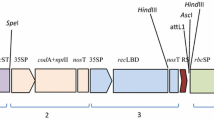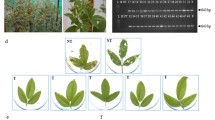Abstract
Agrobacterium-mediated genetic transformation was applied to produce beet armyworm (Spodoptera exigua Hübner) resistant tropical shallots (Allium cepa L. group Aggregatum). A cry1Ca or a H04 hybrid gene from Bacillus thuringiensis, driven by the chrysanthemum ribulose-1,5-bisphosphate carboxylase/oxygenase small subunit (Rubisco SSU) promoter, along with the hygromycin phosphotransferase gene (hpt) driven by the CaMV 35S promoter, was employed for genetic transformation. An average transformation frequency of 3.68% was obtained from two shallot cultivars, Tropix and Kuning. After transfer of the in vitro plants to the greenhouse 69% of the cry1Ca and 39% of the H04 transgenic shallots survived the first half year. After one year of cultivation in the greenhouse the remaining cry1Ca and H04 transgenic plants grew vigorously and had a normal bulb formation, although the cry1Ca transgenic plants (and controls) had darker green leaves compared to their H04 counterparts. Standard PCR, adaptor ligation PCR and Southern analyses confirmed the integration of T-DNA into the shallot genome. Northern blot and ELISA analyses revealed expression of the cry1Ca or H04 gene in the transgenic plants. The amount of Cry1Ca expressed in transgenic plants was higher than the expression levels of H04 (0.39 vs. 0.16% of the total soluble leaf proteins, respectively). There was a good correlation between protein expression and beet armyworm resistance. Cry1Ca or H04 gene expression of at least 0.22 or 0.08% of the total soluble protein in shallot leaves was sufficient to give a complete resistance against beet armyworm. This confirms earlier observations that the H04 toxin is more toxic to S. exigua than the Cry1Ca toxin. The results from this study suggest that the cry1Ca and H04 transgenic shallots developed could be used for introducing resistance to beet armyworm in (sub) tropical shallot.
Similar content being viewed by others
Abbreviations
- AL-PCR:
-
adaptor ligation PCR
- Bt :
-
Bacillus thuringiensis
- cry1Ca :
-
a synthetic gene from Bacillus thuringiensis
- GUS:
-
β-glucuronidase
- H04 :
-
a hybrid gene from B. thuringiensis
- hpt :
-
hygromycin phosphotransferase gene
- LB:
-
T-DNA left border
- RB:
-
T-DNA right border
- gusA :
-
β-glucuronidase gene
References
MJ Brewer JT Trumble B Alvarado-Rodriguez WE Chaney (1990) ArticleTitleBeet armyworm (Lepidoptera: Noctuidae) adult and larva susceptibility to three insecticides in managed habitats and relationship to laboratory selection for resistance J Econ Entomol 83 2136–2146
MJ Brewer JT Trumble (1991a) ArticleTitleClassifying resistance severity in field populations: Sampling inspection plans for an insecticide resistance monitoring program J Econ Entomol 84 379–389
MJ Brewer JT Trumble (1991b) ArticleTitleInheritance and fitness consequences of resistance to fenvalerate in Spodoptera exigua (Lepidoptera: Noctuidae) J Econ Entomol 84 1638–1644
Carozzi NB, Rabe SM, Miles PJ, Warren GW and de Haan PT (2002) Novel insecticidal toxins derived from Bacillus thuringiensis crystal proteins. International Application Published Under The Patent Cooperation Treaty WO 02/15701.
EY Cheng CH Kao (1993) ArticleTitleInsecticide resistance study in Spodoptera exigua (Hübner) I. Detecting the resistance in a general survey Journal of Agri Res China 42 396–402
B De Cosa W Moar SB Lee M Miller H Daniell (2001) ArticleTitleOverexpression of Bt cry2Aa2 operon in chloroplasts leads to formation of insecticidal crystals Nat Biotechnol 19 71–74 Occurrence Handle11135556
RA De Maagd MSG Kwa H Klei Particlevan der T Yamamoto B Schipper et al. (1996) ArticleTitleDomain III substitution in Bacillus thuringiensis delta-endotoxin CryIA(b) results in superior toxicity for Spodoptera exigua and altered membrane protein recognition Appl Environ Microbiol 62 1537–1543 Occurrence Handle8633853
RA De Maagd M Weemen-Hendriks W Stiekema D Bosch (2000) ArticleTitleBacillus thuringiensis delta-endotoxin Cry1C domain III can function as a specificity determinant for Spodoptera exigua in different, but not all, Cry1-Cry1C hybrids Appl Environ Microbiol 66 1559–1563 Occurrence Handle10742242
RA De Maagd A Bravo N Crickmore (2001) ArticleTitleHow Bacillus thuringiensis has evolved specific toxins to colonize the insect world Trends Gen 17 193–199
CC Eady RJ Weld CE Lister (2000) ArticleTitleAgrobacterium tumefaciens-mediated transformation and transgenic-plant regeneration of onion (Allium cepa L.) Plant Cell Rep 19 376–381
CC Eady S Davis J Farrant J Reader F Kenel (2003a) ArticleTitleAgrobacterium tumefaciens-mediated transformation and regeneration of herbicide resistant onion (Allium cepa) plants Ann Appl Biol 142 213–217
CC Eady J Reader S Davis T Dale (2003b) ArticleTitleInheritance and expression of introduced DNA in transgenic onion plants (Allium cepa) Ann Appl Biol 142 219–224
EE Hood GL Helmer RT Fraley MD Chilton (1986) ArticleTitleThe hypervirulence of Agrobacterium tumefaciens A281 is encoded in a region of pTiBo542 outside of T-DNA J Bacteriol 168 1291–1301 Occurrence Handle3782037
EE Hood SB Gelvin LS Melchers A Hoekema (1993) ArticleTitleNew Agrobacterium helper plasmids for gene transfer to plants Trans Res 2 208–218
GR Lazo PA Stein RA Ludwig (1991) ArticleTitleA DNA transformation-competent Arabidopsis genomic library in Agrobacterium Bio/Technol. 9 963–967
D Mattanovich F Rüker ADC Machado M Laimer F Regner et al. (1989) ArticleTitleEfficient transformation of Agrobacterium spp. by electroporation Nucleic Acids Res 17 6747 Occurrence Handle2674902
P McCullagh JA Nelder (1990) Generalized Linear Models Chapman and Hall London and New York
S Naimov S Dukiandjiev RA Maagd Particlede (2003) ArticleTitleA hybrid Bacillus thuringiensis delta-endotoxin gives resistance against a coleopteran and a lepidopteran pest in transgenic potato Plant Biotechnol J 1 51–57
S Ohta S Mita T Hattori K Nakamura (1990) ArticleTitleConstruction and expression in tobacco of a beta-glucuronidase (GUS) reporter gene containing an intron within the coding sequence Plant Cell Physiol 31 805–813
NS Outchkourov J Peters J De Jong W Rademakers MA Jongsma (2003) ArticleTitleThe promoter-terminator of chrysanthemum rbcS1 directs very high expression levels in plants Planta 216 1003–1012 Occurrence Handle12687368
FJ Perlak M Oppenhuizen K Gustafson R Voth S Sivasupramaniam et al. (2001) ArticleTitleDevelopment and commercial use of BollgardR cotton in the USA: early promises versus today’s reality Plant Journal 27 489–501 Occurrence Handle11576434
C Sallaud D Meynard J Boxtel Particlevan C Gay M Bès et al. (2003) ArticleTitleHighly efficient production and characterization of T-DNA plants for rice (Oryza sativa L.) functional genomics Theor Appl Genet 106 1396–1408 Occurrence Handle12677401
J Sambrook EF Fritsch T Maniatis (1989) Molecular Cloning: A Laboratory Manual EditionNumber2 Cold Spring Harbor Laboratory Press Plainview, NY
E Schnepf N Crickmore J Rie Particlevan D Lereclus J Baum et al. (1998) ArticleTitleBacillus thuringiensis and its pesticidal crystal proteins Microbiol Mol Biol Rev 62 775–806 Occurrence Handle9729609
TH Schuler GM Poppy BR Kerry I Denholm (1998) ArticleTitleInsect-resistant transgenic plants Trends Biotechnol 16 168–175
N Strizhov M Keller J Mathur KZ Koncz D Bosch et al. (1996) ArticleTitleA synthetic cryIC gene, encoding a Bacillus thuringiensis delta-endotoxin, confers Spodoptera resistance in alfalfa and tobacco Proc Natl Acad Sci USA 93 15012–15017 Occurrence Handle8986755
M Takai S Wakamura (1990) ArticleTitleControl of the beet armyworm, Spodoptera exigua (Lepidoptera: Noctuidae), using synthetic sex pheromone II Effect of communication disruption in the greenhouse and combination effect with light-trap. Jap J Appl Entomol Zool 34 115–120
M Takai S Wakamura (1996) ArticleTitleControl of the beet armyworm, Spodoptera exigua (Hübner), with synthetic sex pheromone Agrochem Japan 69 12–15
J Tu G Zhang K Datta C Xu Y He et al. (2000) ArticleTitleField performance of transgenic elite commercial hybrid rice expressing Bacillus thuringiensis delta-endotoxin Nat Biotechnol 18 1101–1104 Occurrence Handle11017051
AW Van Heusden JW Ooijen Particlevan R Vrielink-van Ginkel WHJ Verbeek WA Wietsma et al. (2000) ArticleTitleA genetic map of an interspecific cross in Allium based on amplified fragment length polymorphism (AFLPTM) markers Theor Appl Genet 100 118–126
S Wakamura M Takai A Yamamoto H Inoue M Kawamura (1990) ArticleTitleControl of the beet armyworm, Spodoptera exigua (Hübner), (Lepidoptera: Noctuidae), using synthetic sex pheromone IV Effect of communication disruption in Welsh onion fields in 1988 IssueIDAppl Ent Zool 25 320–323
SJ Zheng B Henken E Sofiari E Jacobsen FA Krens et al. (1998) ArticleTitleFactors influencing induction, propagation and regeneration of mature zygotic embryo-derived callus from Allium cepa L Plant Cell, Tissue Organ Culture 53 99–105
SJ Zheng B Henken E Sofiari P Keizer E Jacobsen et al. (1999) ArticleTitleThe effect of cytokinins and lines on plant regeneration from long-term callus and suspension cultures of Allium cepa L Euphytica 108 83–90
SJ Zheng B Henken E Sofiari E Jacobsen FA Krens et al. (2000) ArticleTitleDevelopment of bio-assays and screening for resistance to beet armyworm (Spodoptera exigua Hübner) in Allium cepa L. and its wild relatives Euphytica 114 77–85
SJ Zheng L Khrustaleva B Henken E Sofiari E Jacobsen et al. (2001a) ArticleTitleAgrobacterium tumefaciens-mediated transformation of Allium cepa L.: the production of transgenic onions and shallots Mol Breed 7 101–115
SJ Zheng B Henken E Sofiari E Jacobsen FA Krens et al. (2001b) ArticleTitleMolecular characterization of transgenic shallots (Allium cepa L.) by adaptor ligation PCR (AL-PCR) and sequencing of genomic DNA flanking T-DNA borders Trans Res 10 237–245
SJ Zheng B Henken YK Ahn FA Krens C Kik (2004) ArticleTitleThe development of a reproducible Agrobacterium tumefaciens transformation system for garlic (Allium sativum L.) and the production of transgenic garlic resistant to beet armyworm (Spodoptera exigua Hübner) Mol Breed 14 293–307
J Zhou TC Pesacreta RC Brown (1999) ArticleTitleRNA isolation without gel formation from oligosaccharide-rich onion epidermis Plant Mol Biol Rep 17 397–407
Author information
Authors and Affiliations
Corresponding author
Rights and permissions
About this article
Cite this article
Zheng, SJ., Henken, B., Maagd, R.A.d. et al. Two different Bacillus thuringiensis toxin genes confer resistance to beet armyworm (Spodoptera exigua Hübner) in transgenic Bt-shallots (Allium cepa L.). Transgenic Res 14, 261–272 (2005). https://doi.org/10.1007/s11248-005-0109-2
Received:
Accepted:
Issue Date:
DOI: https://doi.org/10.1007/s11248-005-0109-2




